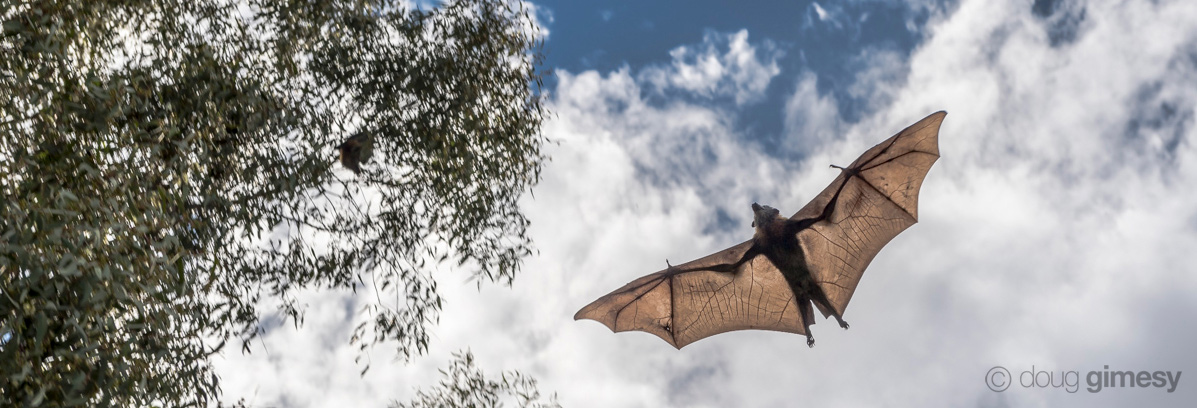This article was adapted from the wonderful website created by Bat Conservation and Rescue Qld.

Bats are an integral part of our ecosystems and fill critical niches that have evolved over millions of years. Bat species display an abundant diversity of dietary practices, varying from species which feed on insects and small fish to species which feed on fruit, nectar and pollen.
Each of these species provides beneficial ecosystem services as either primary, secondary, or tertiary consumers, assisting and supporting the health of ecosystems.
The importance of flying-foxes

Flying-foxes – or Fruit Bats as they are often known – are Australia’s most efficient tree pollinators and seed dispersers within native forests.
They are Australia’s ONLY nocturnal, long distance pollinators and seed dispersers.
Flying-foxes are fundamental to the preservation of forest diversity. They transport and relocate seeds across different ecosystems as they fly between food sources, aiding in pollination and ensuring genetic diversity.
The bats achieve this:
- by carrying the fruit away and unintentionally dropping it
- by carrying the fruit away, consuming the flesh and spitting out the seeds
- eating the fruit and seeds, digesting the seeds then defecating them out 12-34 minutes later.
Black and Grey-headed flying-foxes are crucial for the pollination and seed dispersal of eastern and northern Australian eucalypt forests, delivering pollination and seed dispersal over vast distances. They accomplish this by collecting significant amounts of pollen on their fur and whiskers as they move amongst the flowers of Eucalypts or Melaleuca in search of nectar. This pollen is then transported to the next tree – which may be several kilometres away – and deposited on the flower’s stigma. This type of pollination is referred to as cross-pollination and is essential for eucalypt species.
The ecosystem services that flying-foxes provide make them Australia’s secret weapon against climate change. Additionally, they play a critical role in helping restore land destroyed by bush fires.
The importance of microbats

Microbats play a critical role in ecosystems across Australia as insectivores and as prey species for other animals such as owls and snakes.
Their high position on the food chain, widespread distribution and evolutionary stability make microbats a reliable bioindicator of ecosystem health.
Microbats play an important role in controlling insect numbers, including a range of pest species and disease carrying mosquitoes, as they eat around 40% of their body weight of insects each night. That is the equivalent of an average human that weighs 70kg eating 117 Big Macs each night.
Consumption of this volume of insects is believed to affect population sizes of invertebrate prey species, with benefits to the health of trees, pastures, crops and revegetated areas.
There is increasing evidence of the economic value of microbats for agricultural production, with significant evidence that bats praying on insect herbivores has resulted in significantly increased crop yields and reduction in chemical pesticide costs.
Due to microbats’ small size, decrease in species numbers, nocturnal behaviour and cryptic roosting habits, they are rarely seen by landholders or the general public and are subsequently frequently overlooked in biodiversity assessments and fragmentation research.
Despite their ecological significance, bats are often portrayed negatively in the media and are feared by many people, detracting from their ecological importance and negatively impacting their conservation. Hopefully, a little bit of education and some positive publicity can help these beautiful creatures be recognised as the ecological wonders that they are.
Please remember – NEVER handle or attempt to rescue bats yourself. If you have an injured bat, flying fox or microbat needing assistance in Victoria please visit https://www.flybynight.org.au/ or call 0409 530 541.
If a bat bites or scratches a human, it may have to be destroyed and sent for testing for Australian Bat Lyssavirus – do not risk the bat’s life or your health. Only people trained and Rabies vaccinated should handle bats.
Always call one of the organisations listed below to seek advice and wait for a wildlife carer to arrive and help.
BCRQ provide the following tips:
- Any bat by itself through the day is in trouble.
- A flying-fox hanging on overhead power lines may still be alive. Even if dead, it may be a mother with a live baby tucked up under her wing.
- If you find a flying-fox caught on a barbed wire fence, please very carefully and without touching it, throw a towel over the bat to help keep it calm.
- If you find a flying-fox caught in fruit tree netting, do not try and cut the bat out of the net.
- If the bat is on the ground, please cover the bat with a cardboard box or a washing basket to contain it.
- Keep children and pets away from the bat to help minimise its stress and remember, NO TOUCH NO RISK!
Bat Conservation and Rescue Qld is a registered not-for-profit volunteer organization that strives to help people understand the importance
of all bat species, to provide a prompt and humane rescue service, to raise orphans and to rehabilitate injured bats before returning them to the wild.
BCRQ offers this free 24/7 community service all year round including public holidays.
Fly By Night is a licenced DELWP Wildlife Shelter in Melbourne and is run entirely by volunteers dedicated to the rescue & rehabilitation of the threatened Grey Headed Flying Fox, as well as other native bats and wildlife.
Important numbers:
Wildlife Victoria 03 8400 7300
Help for Wildlife 0477 555 611
Wildlife Rescues 0417 506 941
Aware Wildlife 0412 433 727

